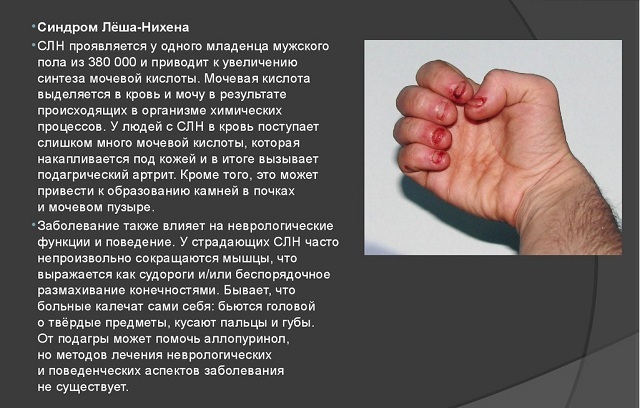 Microcephaly is a disease in which there is a decrease in the size of the brain by 25% or more, and as a consequence, the size of the head. Violation can be primary and secondary, when its development provokes pathological processes.
Microcephaly is a disease in which there is a decrease in the size of the brain by 25% or more, and as a consequence, the size of the head. Violation can be primary and secondary, when its development provokes pathological processes.
One of the main symptoms of microcephaly is the underdeveloped hemisphere of the brain. This disorder is often combined with other pathologies, such as aplasia of the corpus callosum, weak development of the cranial nerves and others.
When a child with such a pathology is born in a family, there is a need for a medical genetic examination. This is necessary in order to assess the possible risk of the appearance in this family of a second child with a similar violation.
If symptoms of microcephaly are detected, it is necessary to consult a pediatrician and a neurologist, and the peculiarities of the upbringing of such children require the observation of a defectologist and speech therapist.
Pathogenesis and causes of anomaly
The form of the disease microcephaly can be divided into primary and secondary.
The primary cause is most often a genetic disorder or an unfavorable course of the first and beginning of the second trimester of pregnancy in the mother.
In cases of a secondary form of the disease, the condition of the patient is more severe, as a rule, cerebral palsy occurs. The secondary form of microcephaly is caused by unfavorable factors during the second and third trimester of pregnancy, during childbirth or in the first months of the child's life.
The main causes, the consequence of which may become microcephaly:
- infectious diseases of the mother in the period of gestation;
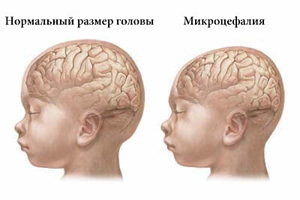
- disorders in the endocrine system of a pregnant woman;
- abuse of the future mother by alcohol, cigarettes, drugs;
- taking certain medications during pregnancy;
- poor ecology and radiological impact;
- toxic effects of harmful substances on the body of a pregnant woman, poisoning;
- genetic disorders;
- birth injury in a child.
In addition, rubella, measles, mumps and other infectious diseases that the expectant mother suffered during the gestation period can also cause abnormal development.
What does it look like?
One of the main symptoms of microcephaly in children is the reduced circumference of the head. Over time, the child's skull grows longer, but the facial part continues to develop according to age. The disproportion of the cerebral and facial parts of the skull develops and becomes more obvious.
Other, often common signs of microcephaly, include the following violations:
- muscle tone is broken;
- the child lags behind in mental development;
- the big fontanel closes before the put( in some cases it occurs already at the moment of a birth);
- there are serious violations in motor and speech development;
- the presence of hyperactivity;
- observed paresis and paralysis;
- impaired coordination of movements;
- convulsions;
- low growth or dwarfism.
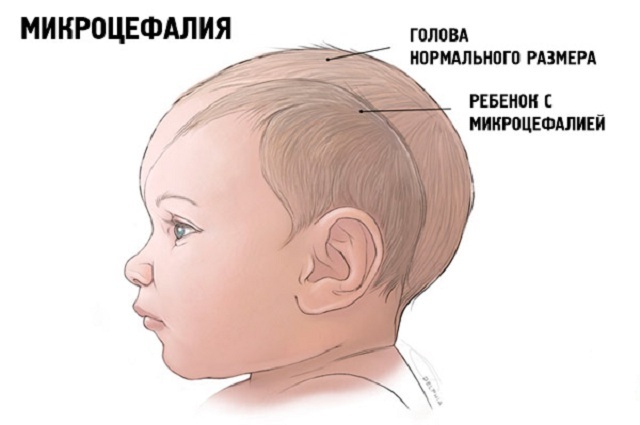
Among children born with such an anomaly, there are those whose intellectual development corresponds to the age, and the head circumference increases as it grows. But in these cases, the size of the head in such children is less than normal.
How microcephaly looks in children in children can be seen in the photo and in the video material:

Diagnostics features of
It is not difficult to diagnose microcephaly, it is based on the definition of morphological parameters and revealing signs of underdevelopment of the intellect in a child.
It is also diagnosed during pregnancy, it allows to identify the accompanying pathologies in the development of the fetus and the risk of an anomaly such as microcephaly.
This is detected by obstetric ultrasound, when the biometric parameters of the fetus are compared, corresponding to a certain period of pregnancy. However, it is possible to detect signs of abnormality in the fetus only on the 27th and 30th week of pregnancy.
In this regard, if there are suspicions of the development of such pathologies due to genetic or chromosomal abnormalities, it is necessary to conduct additional examinations.
To determine the degree of development of pathology, it is possible using methods such as neurosonography, CT and MRI of the brain region, EEG, and radiography.
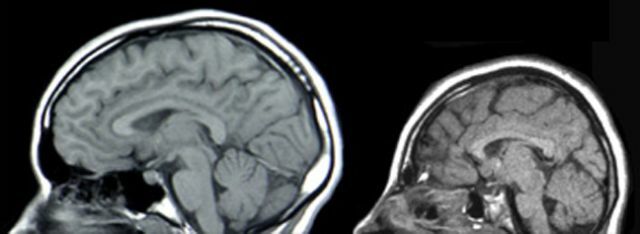
Approach to therapy - what are the chances and opportunities?
There are no methods of treating cerebral microcephaly that can specifically affect this anomaly. Treatment is conducted according to the symptoms caused by this disease.
The aim of treating microcephaly is to influence the disorders that were caused by it. The methods of action are aimed at stopping the emerging symptoms, that is, treating the consequences, and it is not possible to influence microcephaly.
As a treatment, modern medicine offers medical therapy, the essence of which is to positively influence the metabolic processes in the brain tissues.
In the process of drug treatment, sedatives and anticonvulsants are used, as well as medicines shown in the disease caused by microcephaly.
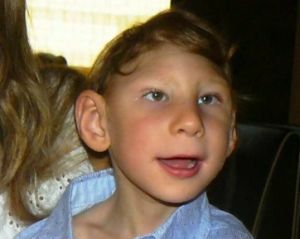 As additional measures that are carried out with children who have similar disorders, they appoint occupational therapy, massage and physical therapy.
As additional measures that are carried out with children who have similar disorders, they appoint occupational therapy, massage and physical therapy.
In other words, as the main activities, such as symptomatic treatment, all measures are reduced to ensuring the socialization and adaptation of children with this disease. In addition, patients are under clinical supervision of specialized specialists.
The complexity in the treatment of microcephaly is that modern medicine does not know how to affect this anomaly, hence there is no possibility of a complete cure for such patients.
Predicting an unfavorable case
Forecasts for patients suffering from microcephaly are quite contradictory. As for the social adaptation of children, some of them are sufficiently developed to be trained in correctional classes, it is possible to instill in them elementary skills of self-service that they can realize.
But most of these patients are forced to be kept for life in specialized boarding schools for mentally retarded children.
In addition, the life expectancy of children with microcephaly is significantly reduced, so the overall outlook is determined as unfavorable.
Reduce risks is possible!
Turning to the issue of preventing the occurrence of an anomaly, it should be noted that at present there are no measures that can guarantee with 100% guarantee the birth of a child with such disorders. However, there are ways, with the help of  , which can significantly reduce the risk of disease.
, which can significantly reduce the risk of disease.
First of all, pregnancy needs to be planned, to undergo a complete examination aimed at revealing the future mother of having infections that can give impetus to the development of pathologies. In addition, women who are not sick with measles and chicken pox should be vaccinated against these diseases.
When planning the birth of a child, prospective parents need to give up smoking, drinking alcohol and drugs in advance. A healthy lifestyle plays an important role in the birth of a healthy child.
In addition, if somatic diseases occur in the expectant mother during pregnancy, it is necessary to take measures for their treatment in a timely manner, this will reduce the risk of microcephaly in the child.
An abnormality that was detected at the stage of fetal development is a sufficient reason for the artificial termination of pregnancy.
For families in which there are children, patients with microcephaly, and planning the birth of another child, medical and genetic counseling is mandatory. This is necessary in order to correctly assess the risk of childbirth with a similar violation in subsequent pregnancy.

